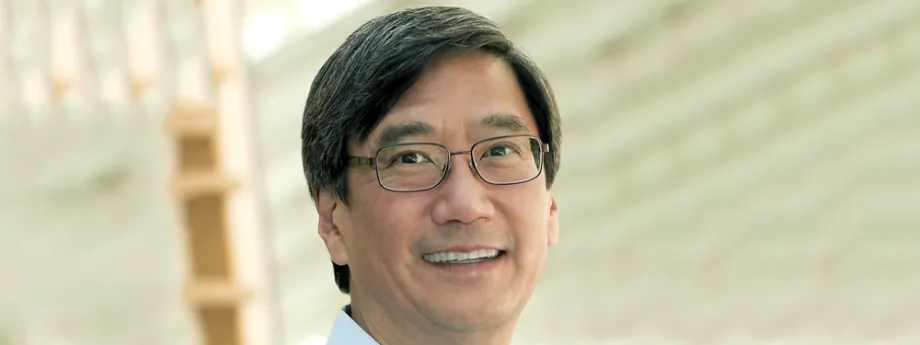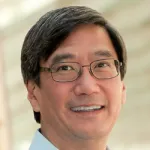
Photo by Craig Hammell: Stanford biochemistry Professor Peter S. Kim will lead the attack on infectious diseases sponsored by the Chan Zuckerberg Biohub.
Stanford News - October 26th, 2016 - by Amy Adams
Attacking infectious diseases will be one focus of the recently announced Chan Zuckerberg Biohub, a collaboration among Stanford University, the University of California, San Francisco and the University of California, Berkeley. Peter S. Kim, professor of biochemistry at Stanford and former president of Merck Research Laboratories, will lead that effort. Stanford Report recently spoke with Kim about the infectious disease project and what he hopes to accomplish.
When Facebook founder Mark Zuckerberg and his wife, Priscilla Chan, announced their Chan Zuckerberg Initiative’s new focus on science in September, it was with the stated mission of investing in science, technology and human ingenuity to help cure, prevent or manage all diseases by the end of the century.
In addition to the physical space and technology provided by the Biohub – with a primary location in the San Francisco Mission Bay district and an outpost located on the Stanford campus in the Lorry I. Lokey Stem Cell Research Building – the Biohub will fund five-year Chan Zuckerberg investigators at the three universities and will carry out research in two focus areas: the cell atlas and infectious disease. It is co-led by Stephen Quake, professor of bioengineering and applied physics at Stanford, and Joseph DeRisi, professor of biochemistry and biophysics at UCSF.
The Chan Zuckerberg Initiative announced a big goal for its science investment. Do you think it’s achievable?
The mission is, on the surface, completely outrageous. Cure, prevent or manage every disease by the end of the century? But in his presentation Mark made the point that all the advances we take for granted in medicine and the enormous increase in the average human lifespan have occurred in only 100 years. Then he says, “So what do you expect to happen by the end of the century?” This argument took me from incredulous to “I don’t know, maybe it could happen.”
The second point he made is that we spend 50 times more money treating disease than we do on finding ways to cure or prevent disease. If you are a company and you spent 50 times more dealing with problems than dealing with the future, that’s a failure. That was pretty insightful. I give Mark and Priscilla a ton of credit for coming out with arguments that are unique and compelling.
Is there a particular focus to the work at the Biohub?
The Biohub is going to have a heavy technology, engineering and computer science focus, which makes a lot of sense for the Bay Area and avoids being duplicative with other initiatives. It will also be developing cutting-edge technologies that are applicable to the life sciences. Steve Quake and Joe DeRisi, the co-leaders of the Biohub, are committed to ensuring that people at the three universities will have access to these technologies.
What are the two research projects being run out of the Biohub?
One is the cell atlas project, which has to do with identifying and characterizing all the different types of cells in the body. Using recently developed technologies, the project will not only characterize the cells, but identify the genes that are active in each cell type and manipulate the proteins to learn how the cells behave in health and disease states. Once it’s done, the cell atlas will be a tool available to scientists worldwide.
The second project, which I’m leading, is on infectious disease. That project has four components: detect, respond, treat and prevent.
Can you explain what you hope to accomplish in those four areas?
Detect: With advances in next-generation sequencing it’s possible to detect the genetic material of infectious agents in the blood and cerebrospinal fluid (CSF). Indeed, Joe and Steve have each already made major contributions in this regard. If that technology compares favorably with the standard methods of detection that involve culturing and waiting several days, it could significantly speed detection and identification of infectious agents. Certainly we’re interested in making this technology better and more routine.
We’ll also be interested in developing new tools to detect infections, particularly in geographic areas where we don’t normally have access to cutting-edge technology. For example, a problem in the recent Ebola outbreak was that you would have to ship a blood sample and wait many days to diagnose the infection, which often was too late.
Treat: We aren’t a drug company and we won’t be running clinical trials, but there are two general areas that we want to impact initially. First, we will work with the cell atlas project to better understand interactions between infectious agents and human cells and provide insights and validate potential drug targets that others would want to capitalize on.
Second, we will enhance technology to identify and isolate individual B-cells producing neutralizing antibodies from people who have survived infections. What I would like is for us to be in a situation where if there is a new infectious disease outbreak, we can rapidly create antibodies that are potential therapeutics that we could hand off to a company or agency for scale-up.
Prevent: The most cost-effective way to prevent infectious disease is through vaccines. The focus is not going to be making vaccines per se, but developing new technologies for creating or enhancing vaccines. By focusing on improving vaccine technology we can have an impact beyond an individual disease.
Here I think there are a lot of possibilities. Bioengineers in particular are developing different methods including new nanoparticle-based vaccine technologies and nucleic acid-based technologies that we are interested in developing and testing. We also want to take advantage of advances that have occurred in nanotechnology and in computer-assisted protein design to create new approaches to develop vaccine candidates. We are also interested in using machine-learning strategies to interrogate clinical, laboratory and epidemiological data for insights into preventing disease with vaccines.
Respond: History shows that when outbreaks occur, society is slow to respond. We want to be positioned to be able to activate a team to respond rapidly to a disease outbreak to provide information and materials that will be helpful in fighting the outbreak.
It’s not that we’ll have people sitting around waiting to respond. The idea is we will have the expertise to respond rapidly by the nature of what we are doing when we aren’t responding. We’re going to have a community of investigators that are interacting with the infectious disease project so that when an outbreak occurs people can rapidly get together and contribute.
How does this project relate to work going on in your own lab?
My lab is working on creating vaccines for HIV and other viruses, in addition to a new interest in cancer immunotherapy. Both of these areas have to do with finding novel ways of treating or preventing disease. I also work in collaboration with other labs that are part of Stanford ChEM-H, which spans basic sciences, engineering and medicine to find solutions to human health challenges. These collaborations within Stanford are not unlike the engineering, science and medical collaborations we’ll need to form across Bay Area universities to ensure success of the infectious disease project. It’s similar to my own work but scaled up because we’ll have primary investigators at the Biohub working on the project as well as collaborators at all three universities.

